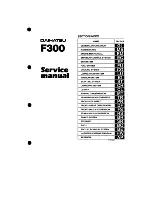
V07268
VIBRATION METHOD: When vibration seems to be the major cause.
CONNECTORS
WIRE HARNESS
PARTS AND SENSOR
1
Slightly shake the connector vertically and horizontally.
Slightly shake the wire harness vertically and horizontally.
The connector joint, fulcrum of the vibration, and body
through portion are the major areas that should be checked
thoroughly.
Apply slight vibration with a finger to the part of the sensor
considered to be the cause of the problem and check wheth-
er or not the malfunction occurs.
Shake Slightly
Swing Slightly
Vibrate Slightly
HINT:
Applying strong vibration to relays may result in open relays.
-
INTRODUCTION
HOW TO TROUBLESHOOT ECU CONTROLLED
SYSTEMS
IN-27
27
Author:
Date:
2005 LEXUS IS300 (RM1140U)
3.
SYMPTOM SIMULATION
The most difficult case in troubleshooting is when no problem symptoms occurring. In such cases, a thor-
ough customer problem analysis must be carried out. Then simulate a simulation of the same or similar
conditions and environment in which the problem occurred in the customer’s vehicle should be carried out.
No matter how much skill or experience a technician has, troubleshooting without confirming the problem
symptoms will lead to something important in the repair operation being overlooked and lead to mistakes
or delays in repairs.
For example:
With a problem that only occurs when the engine is cold, or occurs as result of vibration caused by road dur-
ing driving, the problem can never be determined as long as the symptoms are being checked on stationary
vehicle or a vehicle with a warmed-up engine.
Vibration, heat or water penetration (moisture) is difficult to reproduce. The symptom simulation tests below
are effected substitutes for the conditions and can be applied on a stationary vehicle.
Important Points in the Symptom Simulation Test:
In the symptom simulation test, the problem symptoms as well as problem area or parts must be confirmed.
First, narrow down the possible problem circuits according to the symptoms. Then, connect the tester and
carry out the symptom simulation test, judging whether the circuit being tested is defective or normal, and
also confirming the problem symptoms at the same time. Refer to the problem symptoms table for each sys-
tem to narrow down the possible causes of the symptom.
















































